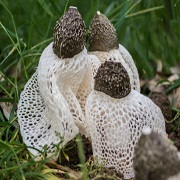HOU Lijuan, LUO Xin, LIN Jinsheng, QU Shaoxuan, JIANG Ning, LI Huiping, XU Ping, MA Lin
The effects of feeding by Bradysia difformis larvae on defensive enzymes of five Pleurotus spp. strains were studied. The five strains were P. ostreatus Xiaobaiping (white), P. ostreatus 8801(gray), P. ostreatus Heiping (black), P. djamor (red), and P. citrinopileatus (yellow), respectively. For each strain, the activities of SOD, CAT, PAL and LOX were measured at six time points (1, 3, 5, 7, 9, 24 h). The results showed that feeding by B. difformis larvae resulted in significant increases of SOD activity in P. ostreatus Xiaobaiping at all time points (P<0.01), in P. ostreatus 8801 at 1 h (P<0.01), 5 h (P<0.05) and 9 h (P<0.05), in P. ostreatus Heiping at 3 h and 24 h (P<0.01), and in P. djamor at 1 h (P<0.01), 3 h (P<0.01), 5 h (P<0.05), 7 h (P<0.01) and 9 h (P<0.01). There was no significant difference in the SOD activity of P. citrinopileatus between B. difformis feeding and the blank control at all time points. In terms of CAT activity, feeding by B. difformis resulted in extremely significant (P<0.01) increases in P. ostreatus 8801 at 9 h, in P. ostreatus Heiping at 9 h and 24 h, in P. djamor at 3 h, 7 h and 24 h, and in P. citrinopileatus at 1 h and 5 h (over two folds). There was no significant difference in the CAT activity of P. ostreatus Xiaobaiping between B. difformis feeding and the blank control at all time points. For PAL activity, feeding by B. difformis larvae resulted in significant increases in P. ostreatus Heiping at 5 h (P<0.01), 7 h (P<0.05), 9 h (P<0.01) and 24 h (P<0.01), in P. djamor at 5 h (P<0.01), and in P. citrinopileatus at 5 h and 7 h (P<0.01). There was no significant difference in the PAL activity of P. ostreatus Xiaobaiping and 8801 at all time points between B. difformis feeding and the blank control. For LOX activity, feeding by B. difformis larvae resulted in significant increases in P. ostreatus Xiaobaiping at 5 h (P<0.01), 7 h (P<0.01), and 9 h (P<0.01), in P. ostreatus 8801 at 24 h (P<0.05), in P. ostreatus Heiping at all time points (P<0.01), and in P. djamor at 1 h (P<0.01), 5 h (P<0.01), 7 h (P<0.01), 9 h (P<0.01), and 24 h (P<0.01). The LOX activity of P. ostreatus Heiping was increased by more than two folds at 3 h compared with the control. There was no significant difference in the LOX activity of P. citrinopileatus between B. difformis feeding and the blank control at all time points.
